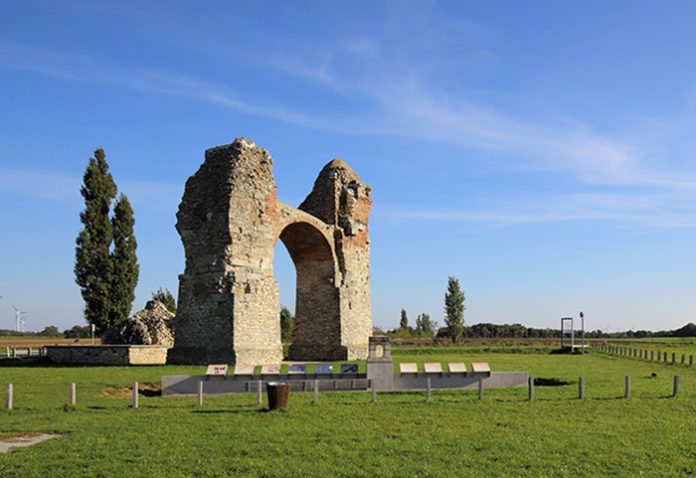Heidentor Monument: An Ancient Symbol of Roman Glory
The Heidentor (Heathen’s Gate) is an ancient Roman monument located at the archaeological site of Carnuntum in present-day Austria. It is one of the most significant remnants of the Roman Empire along its northern frontier and a powerful testament to Roman presence in Central Europe. Below is a detailed discussion of its history, architecture, significance, and present condition:
What is the Heidentor?
Heidentor, which means “Heathen’s Gate” in German, is essentially a triumphal monument built in the 4th century AD in honor of Roman Emperor Constantius II (reigned 337–361 AD). It was originally part of a massive arch that symbolized Roman military and political power.
Today, only a single large arch-shaped wall remains, but in its original form, it was a rectangular structure with at least four arches.
Location and Archaeological Context
Heidentor is located near the modern town of Petronell-Carnuntum in Austria, which was once the ancient Roman city of Carnuntum.
Carnuntum was the capital of the province Pannonia Superior, strategically located on the Danube River, making it militarily, economically, and politically significant.
In Roman times, Carnuntum had a population of around 50,000 people, serving as a legionary camp, trade hub, and administrative center. Heidentor stood just outside the city but was closely connected to it.
Construction and Purpose
Research suggests that the Heidentor was built in the mid-4th century (around 350–355 AD). Its primary purpose was to commemorate the victories of Emperor Constantius II.
Constantius II, the son of Constantine the Great, faced numerous internal and external threats during his reign.
The monument likely celebrated victories over Germanic tribes. It was a type of triumphal arch, but unlike Rome’s famous Arch of Constantine, this one was a quadrifrons structure (four-sided arch), open on all sides.
Architectural Features
The Heidentor clearly displays Roman architectural influence.
Original Design: A square base with four large arches.
Height: Approximately 15 meters in its original form.
Materials: Constructed with limestone and bricks.
Sculptural Elements: It is believed that an imperial statue stood at the center, and the arches were decorated with reliefs.
Location: Situated near a major road outside Carnuntum.
Today, only one arch and part of a wall remain, but it suggests that the monument was once a massive and imposing quadrifrons structure.
Origin of the Name
The term “Heidentor” (Heathen’s Gate) came from medieval misconceptions. After the spread of Christianity, people associated Roman ruins with paganism, hence naming the monument “Heathen’s Gate.” In reality, it was a Roman triumphal monument, not a religious site.
Archaeological Research
The Heidentor was first mentioned in the 16th century, but proper archaeological excavations began in the 19th century. After 1850, conservation efforts started. Recent 3D scanning and archaeological studies have reconstructed its original appearance as a grand triumphal monument dedicated to Constantius II’s military prowess.
Historical Significance
The Heidentor illustrates three major aspects of the Roman Empire:
Military Power: Building such a grand monument in a frontier province demonstrated Rome’s dominance.
Political Propaganda: Constructing monuments to glorify emperors was a common Roman tradition.
Cultural Expansion: Roman architecture was not confined to Rome; it spread across Europe.
It shows that the Romans extended their influence deep into Central Europe.
Current State and Tourism
Today, the Heidentor survives as a partially ruined structure with one arch intact. The surrounding area is now part of the Carnuntum Archaeological Park, where visitors can explore:
Reconstructed Roman houses
A museum
Thermal baths
Various Roman artifacts
Thousands of tourists visit annually to experience Roman history and architecture. The site is preserved as part of Austria’s cultural heritage and is under consideration for inclusion in the UNESCO World Heritage Tentative List.
Why Does the Heidentor Remain Important Today?
Roman Heritage in Europe: It is deeply tied to the history of Europe.
Archaeology and Architecture: It provides insights into urbanization and art in the Roman frontier regions.
Tourism and Education: It serves as a living example of Roman history for scholars and visitors.
The Heidentor is more than just a ruin; it is a symbol of Roman power, architectural mastery, and political influence. Standing resilient through centuries, this monument continues to captivate historians, archaeologists, and tourists alike.
References:
Carnuntum Archaeological Park Official Website
Bidwell, P. Roman Forts in Britain. London: B.T. Batsford Ltd., 2007.

